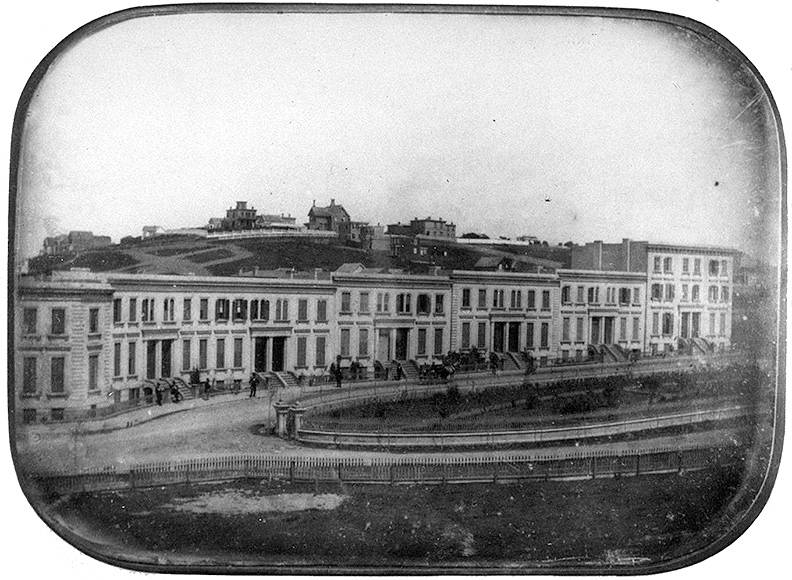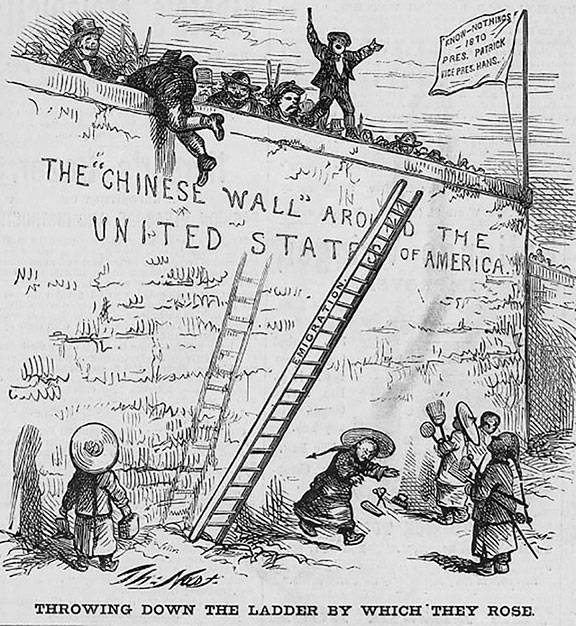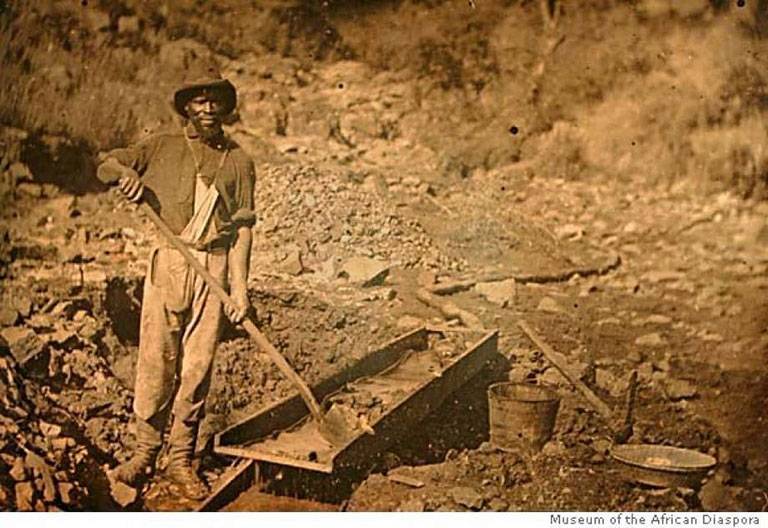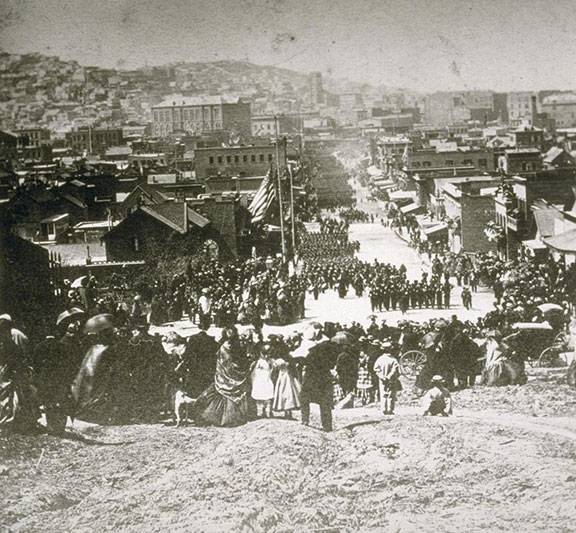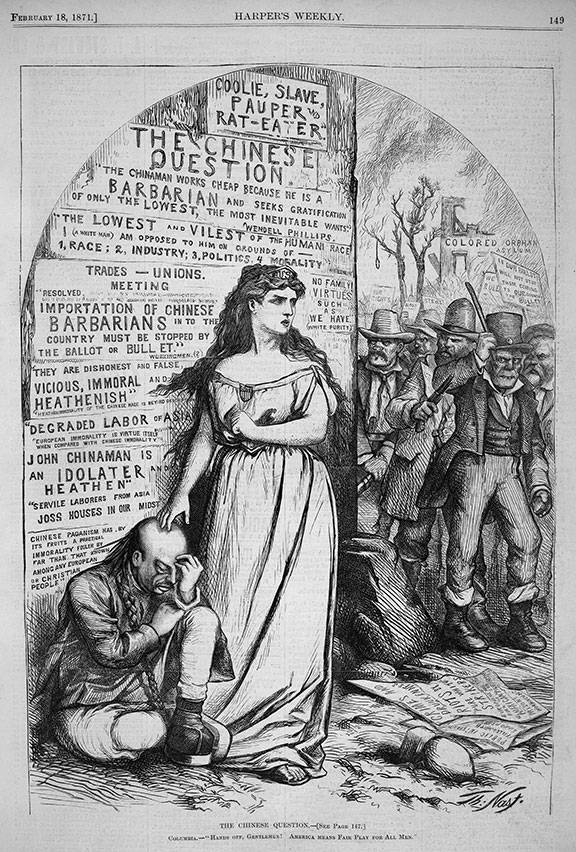Contesting the History of Early American California: Difference between revisions
No edit summary |
added link |
||
| (3 intermediate revisions by 2 users not shown) | |||
| Line 27: | Line 27: | ||
''Image: Harpers Magazine, July 23, 1870'' | ''Image: Harpers Magazine, July 23, 1870'' | ||
That first wave of settlers included many southerners who brought slaves with them. Even after California was granted statehood in 1850 as a “free” state, several thousand people of African descent were held in slavery with the backing of fugitive slave laws passed by the California legislature and approved by the California supreme court. But a growing majority of California’s white men, the only ones who could vote, were embracing the “free soil” ideology of the anti-slavery wing of the Democratic Party. The commitment to free white labor meant that any other group, for example, the thousands of Mexicans, Chileans, Peruvians, and other Spanish-speakers who arrived early to the gold diggings, had to be defined as occupying a different category of work. The push for a “foreign miner’s tax” that lasted until 1852 was designed to drive out the so-called <i>peones, </i>or peons, men who were paid a pittance and sent the products of their labor to their <i>patrones</i>, or bosses. The Spanish-speaking gold miners were defined as less than white men by this argument, and thus subject to violent expulsion. After 1852, when most Spanish-speaking miners had departed, the target of white miners was shifted to the Chinese miners. Before long a new claim was being made about the Chinese workers who had signed contracts and come to work in California: they were “coolies.” This process is well described by Stacey L. Smith in her excellent book [https://www.uncpress.org/book/9781469626536/freedoms-frontier/ ''Freedom’s Frontier: California and the Struggle over Unfree Labor, Emancipation, and Reconstruction''] (University of North Carolina Press: 2013): | That first wave of settlers included many southerners who brought slaves with them. Even after California was granted statehood in 1850 as a “free” state, several thousand people of African descent were [[It Happened Here: A History of Slavery in California|held in slavery]] with the backing of fugitive slave laws passed by the California legislature and approved by the California supreme court. But a growing majority of California’s white men, the only ones who could vote, were embracing the “free soil” ideology of the anti-slavery wing of the Democratic Party. The commitment to free white labor meant that any other group, for example, the thousands of Mexicans, Chileans, Peruvians, and other Spanish-speakers who arrived early to the gold diggings, had to be defined as occupying a different category of work. The push for a “foreign miner’s tax” that lasted until 1852 was designed to drive out the so-called <i>peones, </i>or peons, men who were paid a pittance and sent the products of their labor to their <i>patrones</i>, or bosses. The Spanish-speaking gold miners were defined as less than white men by this argument, and thus subject to violent expulsion. After 1852, when most Spanish-speaking miners had departed, the target of white miners was shifted to the Chinese miners. Before long a new claim was being made about the Chinese workers who had signed contracts and come to work in California: they were “coolies.” This process is well described by Stacey L. Smith in her excellent book [https://www.uncpress.org/book/9781469626536/freedoms-frontier/ ''Freedom’s Frontier: California and the Struggle over Unfree Labor, Emancipation, and Reconstruction''] (University of North Carolina Press: 2013): | ||
<blockquote>...the question that peonage raised about the relationship between capital and labor, between wage work and slavery, between citizens and aliens, and between empire and exclusion did not disappear with the repeal of the foreign miners’ tax. Instead, white Californians transferred the class, racial, and national imaginings associated with peons to a new group of foreign-born laborers. Within just a year, imagined Chinese coolies took the place of peons and started to represent virtually the same threats and fears. The campaign for Chinese exclusion that emerged in California by 1852 had deep roots in the expulsion of Latinos that preceded it. (p. 94)</blockquote> | <blockquote>...the question that peonage raised about the relationship between capital and labor, between wage work and slavery, between citizens and aliens, and between empire and exclusion did not disappear with the repeal of the foreign miners’ tax. Instead, white Californians transferred the class, racial, and national imaginings associated with peons to a new group of foreign-born laborers. Within just a year, imagined Chinese coolies took the place of peons and started to represent virtually the same threats and fears. The campaign for Chinese exclusion that emerged in California by 1852 had deep roots in the expulsion of Latinos that preceded it. (p. 94)</blockquote> | ||
| Line 35: | Line 35: | ||
[[Image:Protecting-the-Settlers--Slaughtering-the-Yuki-in-Round-Valley 1861-Harpers-New-Monthly-Magazine.jpg|330px|right]] | [[Image:Protecting-the-Settlers--Slaughtering-the-Yuki-in-Round-Valley 1861-Harpers-New-Monthly-Magazine.jpg|330px|right]] | ||
'''"Protecting the Settlers?" This image from ''Harper's'' in 1871 depicts the slaughter of California Indians in Round Valley, Mendocino County by a brutal local "militia" paid for by Serranus Hastings, namesake of Hastings College of the Law.''' | '''"Protecting the Settlers?" This image from ''Harper's'' in 1871 depicts the slaughter of California Indians in Round Valley, Mendocino County by a brutal local "militia" paid for by [[Hastings College of Law Built on Genocide?|Serranus Hastings]], namesake of Hastings College of the Law.''' | ||
Californios and Indians were here when the border suddenly shifted hundreds of miles southward, but were quickly defined as “other.” Even legal protections for Californio landowners embodied in the peace treaty that ceded so much Mexican territory to the U.S. were often ignored or rejected in practice as squatters and settlers overwhelmed the smaller population of long-time residents. The indigenous peoples of California were subjected to a horrific genocidal campaign that lasted into the 1870s, killing tens of thousands, enslaving men, women, and children for decades. Later generations of American Californians imagined that California’s physical landscape and remarkable abundance was just sitting here awaiting the pioneers’ arrival, rather then understanding that it had actually been <i>produced</i> by the people who had lived here for thousands of years, and those people lived on the land that was coveted by the incoming Americans. Several excellent books shed light on the complicated, contradictory, and ultimately barbaric process of making California American. Benjamin Madley’s magisterial [https://yalebooks.yale.edu/book/9780300181364/american-genocide ''An American Genocide: TheUnited States and the Californian Indian Catastrophe 1846-1873''] is the go-to book to understand the day-by-day slaughter and enslavement of California Indian peoples during the first decades of American political control. It’s grim reading, but well written and strips bare the barbarism that white Americans imposed. | Californios and Indians were here when the border suddenly shifted hundreds of miles southward, but were quickly defined as “other.” Even legal protections for Californio landowners embodied in the peace treaty that ceded so much Mexican territory to the U.S. were often ignored or rejected in practice as squatters and settlers overwhelmed the smaller population of long-time residents. The indigenous peoples of California were subjected to a horrific genocidal campaign that lasted into the 1870s, killing tens of thousands, enslaving men, women, and children for decades. Later generations of American Californians imagined that California’s physical landscape and remarkable abundance was just sitting here awaiting the pioneers’ arrival, rather then understanding that it had actually been <i>produced</i> by the people who had lived here for thousands of years, and those people lived on the land that was coveted by the incoming Americans. Several excellent books shed light on the complicated, contradictory, and ultimately barbaric process of making California American. Benjamin Madley’s magisterial [https://yalebooks.yale.edu/book/9780300181364/american-genocide ''An American Genocide: TheUnited States and the Californian Indian Catastrophe 1846-1873''] is the go-to book to understand the day-by-day slaughter and enslavement of California Indian peoples during the first decades of American political control. It’s grim reading, but well written and strips bare the barbarism that white Americans imposed. | ||
| Line 97: | Line 97: | ||
''Image: Harper's Weekly'' | ''Image: Harper's Weekly'' | ||
[[category:Labor]] [[category:Power and Money]] [[category:Indigenous]] [[category:African-American]] [[category:Chinese]] [[category:Crime]] [[category:1850s]] [[category:1860s]] [[category:1870s]] [[category:1880s]] [[category:1890s]] | [[category:Labor]] [[category:Power and Money]] [[category:Indigenous]] [[category:African-American]] [[category:Chinese]] [[category:Crime]] [[category:1850s]] [[category:1860s]] [[category:1870s]] [[category:1880s]] [[category:1890s]] [[category:racism]] | ||
Latest revision as of 20:15, 11 February 2021
Historical Essay
by Chris Carlsson, 2018
The Fourth of July being celebrated in Washington Square Park, 1869.
Photo: Shaping San Francisco
South Park, 1862.
Photo: Online Archive of California, I0012522A
The heroic histories of early California have been fed to the state’s schoolchildren, and to the larger culture, since the first wave of American historians began to churn out the self-aggrandizing tales that were meant to exalt the first settlers while painting a simple story of inevitable progress. The real stories are quite a bit more complicated, and in key respects, the reverse of what we’ve been told. California’s jump-started economy in the middle of the 19th century was based not on hardy self-made men, but was based on an industrial model that required large amounts of capital and the abundant natural wealth without which California would have had a very different history. As Andrew Isenberg cogently puts it, “Anglo California’s economic development thus began with industry, later included agriculture, and still later invented wilderness.” (Mining California: An Ecological History, p. 164). The thousands of gold-seekers who rushed to California were themselves imbued with both the white supremacist ideology of Manifest Destiny, and the liberal belief in individualism and personal honor as the foundation of public life. Prior to the Civil War most white men were committed to a republic of individual producers, either small farmers or self-employed artisans and entrepreneurs. The corporation had not yet risen to the powerful position it would assume within a generation, and while plenty of people took jobs working for wages, few thought of it as anything but a transition on the way to self-sufficiency. As Richard White ably describes in his epic history (The Republic for Which It Stands: The United States During Reconstruction and the Gilded Age, 1865-1895, Oxford University Press: 2017):
Free labor depended on independence, and, as Lincoln had said, permanent wage labor signified “either a dependent nature which prefers it, or improvidence, folly, or singular misfortune,” but as the 1860s turned into the 1870s wage labor was becoming not a transitory stage in life but the norm. In 1873 the Massachusetts Bureau of Statistics of Labor proclaimed that wage labor had become “a system more widely diffused than any form of religion, or of government, or indeed, of any language.” Excluding farmers, wageworkers by 1870 outnumbered the self-employed. They did not sell the products of their minds and hands. They sold their hours and days. (p. 237)
It’s not even 200 years since the American seizure of California from Mexico. As Americans poured into the territory seeking their fortunes they aggressively sought to implant a political and economic order that ensured their own well-being and denied it to every everyone else. But they also faced the deep anxiety that accompanied the shifting economic world they were bringing with them, the beginnings of industrial capitalism and wage-labor. The mythological small farmers and self-made men found themselves dependent on wealthy investors and new business syndicates that employed them in seizing the natural wealth of California. While a few became unimaginably wealthy, most American California settlers were boxed in by lack of capital and a lack of land, forced to find employment with those who could command their labor with wages.
Early sentiment for wall building!
Image: Harpers Magazine, July 23, 1870
That first wave of settlers included many southerners who brought slaves with them. Even after California was granted statehood in 1850 as a “free” state, several thousand people of African descent were held in slavery with the backing of fugitive slave laws passed by the California legislature and approved by the California supreme court. But a growing majority of California’s white men, the only ones who could vote, were embracing the “free soil” ideology of the anti-slavery wing of the Democratic Party. The commitment to free white labor meant that any other group, for example, the thousands of Mexicans, Chileans, Peruvians, and other Spanish-speakers who arrived early to the gold diggings, had to be defined as occupying a different category of work. The push for a “foreign miner’s tax” that lasted until 1852 was designed to drive out the so-called peones, or peons, men who were paid a pittance and sent the products of their labor to their patrones, or bosses. The Spanish-speaking gold miners were defined as less than white men by this argument, and thus subject to violent expulsion. After 1852, when most Spanish-speaking miners had departed, the target of white miners was shifted to the Chinese miners. Before long a new claim was being made about the Chinese workers who had signed contracts and come to work in California: they were “coolies.” This process is well described by Stacey L. Smith in her excellent book Freedom’s Frontier: California and the Struggle over Unfree Labor, Emancipation, and Reconstruction (University of North Carolina Press: 2013):
...the question that peonage raised about the relationship between capital and labor, between wage work and slavery, between citizens and aliens, and between empire and exclusion did not disappear with the repeal of the foreign miners’ tax. Instead, white Californians transferred the class, racial, and national imaginings associated with peons to a new group of foreign-born laborers. Within just a year, imagined Chinese coolies took the place of peons and started to represent virtually the same threats and fears. The campaign for Chinese exclusion that emerged in California by 1852 had deep roots in the expulsion of Latinos that preceded it. (p. 94)
Smith offers a wider view of the struggle over different labor regimes during the pre-Civil War decade through the end of Reconstruction in the mid-1870s. Her argument penetrates the fraught beginnings of wage-labor in the pre-Civil War west, and how the struggles over the definition of free and unfree labor came to shape the national discourse by the end of Reconstruction in the mid-1870s. She includes detailed accounts of slavery in California, backed up with many examples and evidence from the press of the time. She goes through the legal battles in the state legislature that led to the passage of the 1850 Act for the Government and Protection of Indians and the fugitive slave law that together rendered California’s ostensible status as a “free state” a mendacious claim at best.
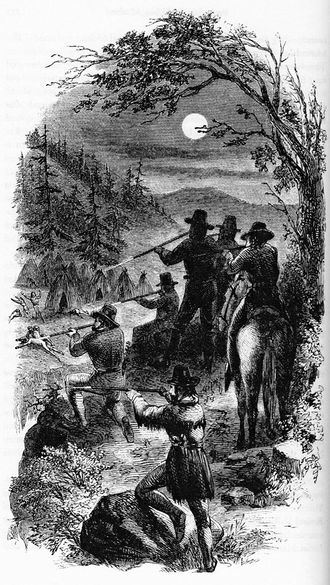
"Protecting the Settlers?" This image from Harper's in 1871 depicts the slaughter of California Indians in Round Valley, Mendocino County by a brutal local "militia" paid for by Serranus Hastings, namesake of Hastings College of the Law.
Californios and Indians were here when the border suddenly shifted hundreds of miles southward, but were quickly defined as “other.” Even legal protections for Californio landowners embodied in the peace treaty that ceded so much Mexican territory to the U.S. were often ignored or rejected in practice as squatters and settlers overwhelmed the smaller population of long-time residents. The indigenous peoples of California were subjected to a horrific genocidal campaign that lasted into the 1870s, killing tens of thousands, enslaving men, women, and children for decades. Later generations of American Californians imagined that California’s physical landscape and remarkable abundance was just sitting here awaiting the pioneers’ arrival, rather then understanding that it had actually been produced by the people who had lived here for thousands of years, and those people lived on the land that was coveted by the incoming Americans. Several excellent books shed light on the complicated, contradictory, and ultimately barbaric process of making California American. Benjamin Madley’s magisterial An American Genocide: TheUnited States and the Californian Indian Catastrophe 1846-1873 is the go-to book to understand the day-by-day slaughter and enslavement of California Indian peoples during the first decades of American political control. It’s grim reading, but well written and strips bare the barbarism that white Americans imposed.
Where Benjamin Madley details every murder and so-called “militia” campaign against California Indians in all parts of the state for 30 years, Stacey Smith looks more closely at the way state laws fueled a burgeoning trade of buying and selling Indians, especially those under the age of 21. She also presents a number of galling examples of state courts approving the re-enslavement of free blacks and their export back to slave states.
Between 1852 and 1855, California and East Coast newspapers reported the stories of dozens of slaves dragged before state courts and remanded to their owners. When one enslaved woman married a free black man in late 1852, her master forced her before a San Francisco court. Once the slaveholder rendered “satisfactory proof of title” to her, the judge approved her deportation to Missouri. (p. 72)
By 1855 cracks in the legal system began to appear, as various formerly enslaved people were freed by state courts on the grounds that they had been held illegally as slaves in California. (Some were encouraged to seek their legal freedom by armed blacks, already free, who traveled through San Joaquin county exhorting slaves to run away.) Judges agreed with lawyers who argued that if they had been brought by their owners after 1850, and had not sought to escape in their original slave state or en route, then they had not broken any laws by running away in California. Yearly campaigns by slave owning southern Californians to separate California into two states were thwarted by anti-slavery votes in the state legislature. There were estimated to be nearly 3,000 enslaved African Americans in California, one-quarter to one-third under the age of 21, during the 1850s. When the Civil War started, most Californian slaveowners returned to the south to fight for the Confederacy (along with a number of well known San Franciscans such as Senator William Gwin and the celebrated Lillie Hitchcock Coit).
But the state legislature had passed a further act in 1860 allowing “apprenticeship” to be imposed on almost any California Indian deemed “vagrant,” stimulating more slaughter and slaving by whites determined to take advantage of Indian labor. When the Emancipation Proclamation was issued by President Lincoln in 1863, the state legislature repealed those 1860 amendments, an act that has been interpreted by most historians as California falling in line with the national policy on slavery. But Smith offers a more nuanced explanation:
While Republican antislavery sentiment and attentiveness to African American freedom certainly influenced repeal, the measure may actually have passed because it did not bring full emancipation for California’s Indian workers… The bill that passed in 1863 repealed the 1860 apprenticeship amendments but did not touch many of the other compulsory labor provisions of the original 1850 Act for the Government and Protection of Indians. Indian vagrants could still be bound out to work four-month terms. Native convicts still faced whipping for certain crimes and could be forced to work for whites who paid their bail. (p. 126)
The most invisible slavery in mid-19th century California was that imposed on Indian and Black children. Due to the prevailing patriarchal norms of the time, male heads of households controlled all property and labor of their family members. Rooted in Spanish colonialism and the decades of Mission life, subordination of indigenous children to household labor was common not only in California, but throughout the southwest, Mexico, Venezuela, and other parts of Latin America. Stacey Smith again:
Unlike chattel slavery, “coolieism,” or “peonism,” the unfree labor of American Indian and African American wards generated little protest or comment. Once absorbed into new households, children’s bondage became legally and culturally invisible. When the law transformed young people from captives and slaves into wards, it recast relations of labor exploitation into family relations. Wardship turned black and Indian children into the domestic dependents of white and Californio householders, who now had legitimate parental and paternal rights to their labor. (p. 111)
Holding African American children as “wards” also gave white slave owners additional leverage over their enslaved parents, who were less likely to run away and leave their children behind, and were also less likely to resist their work demands. The hidden slavery of children is probably one of the least known aspects of 1850s California. One quarter of northern California households had a slave Indian child in the home during that decade, according to Madley’s research.
A widely reproduced image of a black gold miner during the Gold Rush... was he free or a slave?
Image: Museum of the African Diaspora
Other forms of forced labor were developing alongside this patriarchal regime. Women were famously imported from China to work in brothels (plenty of white women came to California and found sex work as their best or only option, too). Alongside the thousands of Chinese male laborers who were brought as contract laborers to California to work in mining, build the transcontinental railroad and transform the state’s wetlands and valleys into extensive farmlands, all Chinese workers were seen as less than free. A Republican-led committee in the California state legislature came to a different conclusion however, concluding that the “cheap labor” of the Chinese had contributed nearly $14 million to the state’s economy, while arguing that there was no system of slavery or coolieism among the Chinese in California. In spite of this rare public endorsement of Chinese participation in California’s economy, the majority of Democrats and Republicans feared extending full legal rights to Chinese on the grounds that such equality might encourage a “coolie invasion” which in turn “would undermine the legal and economic supremacy of white Americans.” (Smith, p. 179)
Mourners march on 2nd Street in San Francisco after Lincoln's assassination.
Photo: California Historical Society
Simmering in this poisonous stew of white racism, California Democrats regained political power in 1867 after the debacle of being pro-slavery during the Civil War. Sweeping the statewide election, Democrats promised to eradicate “Chinese slavery” and protect free white labor against “coolie slaves and capitalist masters,” both of which were defended by Republicans. Somehow the Democrats had flipped their political identity from pro- to anti-slavery in a few short years, and given the enormous anxiety white workers faced in the industrializing economy, the Democrats gained their support by promising to combat both the rich and the poorer workers that threatened them. While this political sleight of hand was going on, white Americans continued to slaughter California Indians, especially in the north. By the early 1870s, the Modoc War erupted, which pitted settlers in the far north against a shrinking group of Modoc Indians who had already partially integrated into the Yreka economy as laborers. Then, after being ordered to share a reservation with their traditional enemies, the Klamath Indians in southern Oregon, tried to return to their traditional lands near the lava beds of Mt. Lassen. Andrew Isenberg properly assessed the process underway: “The appropriation of the Modocs’ lands and the proletarianization of Modoc labor were remote extensions of the process known as enclosure that began in late medieval and early modern England and occurred elsewhere in northern Europe.” (p. 137)
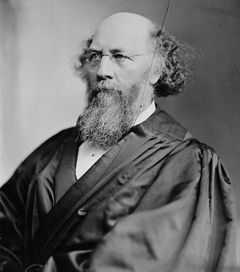
Judge Stephen J. Field, 1875
Photo: Wikimedia Commons
Post-Civil War Reconstruction in California foundered on the same contradictions the South faced: how to expand individualism and contract freedom while using state power to ensure that white men would continue to enjoy legal and economic supremacy. The legal system became a source of legitimation, taking the radical legislation of the thirteenth, fourteenth, and fifteenth amendments meant to eradicate slavery and guarantee equal rights under the law, and redefining them over several decades as laws to defend private property and the “free market.” California judge Stephen J. Field was a chief architect of this transposition of the legal regime created by the post-Civil War efforts to broaden constitutional rights. He applied the fourteenth amendment’s equal protection clause to the needs of corporations, helping to usher in the mysterious legal equivalence of corporations and personhood in a series of decisions in the 1880s. By the 1890s, courts were being used to undermine democratic decisions that promoted social well-being at the expense of corporate profits. Richard White describes it best:
Field and other liberal judges appropriated the democratic language of Jacksonianism, which had sought to protect the many from the few, and turned it into a legal vocabulary that protected the few from the many. Turning people into commodities was impermissible, but turning people’s labor into a commodity—a piece of property to be bought and sold—was the source of progress. Freedom became the protection of property. Rarely has a minority opinion been so influential. (p. 812) By rendering freedom as the ability to dispose of “property”—either labor or capital—liberal judges cast restraints on property as potential attacks on freedom. Depending on the judge or the circumstances, anything that restricted contract freedom—whether licensing laws, certain kinds of public health regulations, strikes, boycotts, or the closed shops—became the legal equivalents of slavery. Such restrictions violated either the rights of workers to pursue a calling or the freedom of citizens to use property as they saw fit. Old protections against seizure of property without due process morphed into the “right” of capital to a fair expected return on investment. (p. 814)
This new legal regime was used repeatedly in the late 19th century to block social legislation that emerged in state and national governments. Regulatory legislation that curtailed sweatshops, required wages to be paid in cash rather than company scrip, mandated shorter workdays, provided various health and safety requirements, and much else, were systematically blocked by the courts. According to White, more than sixty labor laws were struck down between 1880 and 1900.
By the 1890s liberal judges’ expansive approach to the law had achieved breathtaking reach. By embracing classic economic theory, they applied the doctrine of substantive due process to enshrine a set of economic laws that no democratic government could overturn; they transformed metaphorical natural law into a body of actual law created by the judiciary. They treated freedom of contract, open competition, and laissez-faire as part of the Constitution. Judges justified their legal opinions by citing the laws of nature and the “laws” of the market, although neither was to be found on the statue books or in common law. (p. 815)
The current successful campaign by the reactionary Federalist Society to pack the courts under Trump with right-wing ideologues has a strong corollary in the original Gilded Era’s activist courts. It is ironic that the right-wing campaign to take over the judicial branch of government began with claims that liberal judges were “activists” who were inventing legal rights and not sticking to the original intent of the Constitution. But it was the pro-capitalist judges of the late nineteenth century who were the original activist judges, inventing legal precedents that still constrain us today. Corporations and the wealthy who control them, along with their political enablers, have built an edifice that will have to be taken down if we have any hope of altering the course of history.
Imagining California as a bastion of progressive thinking, a “liberal paradise” if you will, demands that we delve deeply into its original white supremacist DNA, and that we unpack the real historic meaning of liberalism. Today’s battles with a resurgent right have only just begun. A future freed from not just the revanchist reactionaries who dominate national politics, but also freed from California’s own sordid history, requires a clean break with the political and legal regime that still shapes our options as we near the third decade of the 21st century.
More racist propaganda, Feb. 18, 1871.
Image: Harper's Weekly


